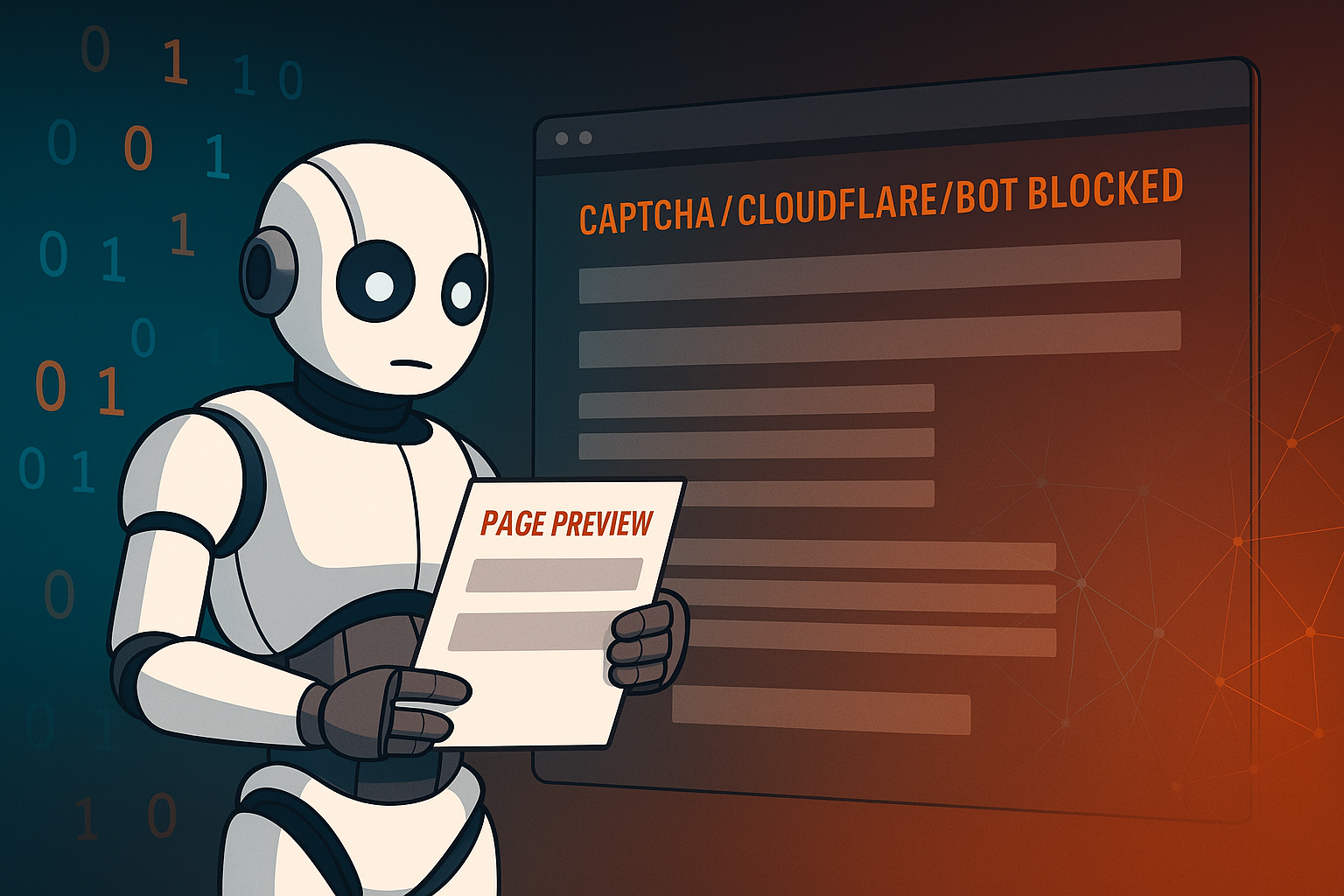Not all websites are created equal in the eyes of these autonomous tools. Many are unintentionally designed in ways that frustrate or repel them.
This matters because these technical and structural obstacles can significantly affect re-ranking. Re-ranking is the process by which AI agents sort or prioritize pages after an initial search. Even if a page is relevant, it may fall in rank or be excluded entirely if it’s hard for an agent to access, interpret or extract useful content from it.
Let’s look at the factors that can shape this hidden hierarchy - and what they mean for business visibility in AI-driven search.
Technical Barriers That Deny Access
Before an agent even reads your content, it must be able to reach it. Many sites are wrapped in web infrastructure designed to protect against malicious bots, but these can also block legitimate AI tools.
- Cloudflare and other CDNs frequently deploy JavaScript-based checks, captchas, and browser fingerprinting. These are designed to thwart scraping, but they also block agents that don’t use full browsers.
- Rate-limiting can kick in when agents make multiple requests in a short period. If a site starts denying access, the agent may abandon the site entirely.
- Geo-blocking means the content may be visible in one country but not in another. If the agent operates from a blocked location, the page may not be evaluated at all.
Each of these factors can cause a page to rank lower - not because the content is poor, but because the agent can’t get in the door.
Pages That Load But Don’t Show Up
Let’s say an agent does gain access. The next hurdle is rendering and loading the page properly.
- Many modern sites use JavaScript-heavy designs where content is built dynamically. Without the ability to execute scripts, some agents may see a blank page.
- Infinite scrolling and lazy loading hide much of the content unless specific user-like actions are triggered. If the agent doesn’t simulate these actions, it may miss most of the information.
- Timeouts matter. If a page takes too long to load, it may be judged too slow or unstable and dropped from the shortlist.
These issues influence re-ranking because the agent uses what it can see and understand to decide what’s useful. If only half the page is visible or the rest loads too slowly, that relevance score drops.
Poor Structure Means Poor Understanding
Even with full access, not all content is equal. Agents rely on well-structured, semantically meaningful pages to determine what matters.
- Pages that rely entirely on
<div>blocks instead of proper headings and sections are harder to interpret. - Missing metadata - such as descriptive titles and meta descriptions - makes it difficult for the agent to summarize what the page is about.
- If the page lacks logical navigation or search functions, the agent may not be able to find the information a user would expect.
As a result, even well-written content may lose out to simpler, better-structured pages.
Access Policies Can Be Invisible Walls
Some sites restrict access by design. These barriers are completely valid from a human perspective but present significant roadblocks for AI agents.
- Login walls and paywalls prevent access to content unless credentials or payment are provided.
- Robots.txt files may explicitly forbid agents from crawling certain sections of the site.
- Pages with session-tied URLs or security tokens may work once, but not on return visits or for different agents.
From a re-ranking perspective, these pages are often excluded early. Agents prefer pages they can access repeatedly and reliably, without special credentials or user actions.
Signals That Lower Usefulness
Even if an agent can access and read the page, some content is easier to work with than others. Pages filled with irrelevant material or repeated content tend to fall behind.
The most common issues include:
- Large blocks of boilerplate or advertising, which drown out the useful text.
- Duplicated content across different pages or domains, which doesn’t add diversity to the agent’s pool of information.
- Pages filled with unnatural language or spam-like signals, which reduce the confidence in the content's reliability.
These signals help agents decide what to show users - and what to filter out.
Why Some Sites Are Never Even Seen
In some cases, the issue isn’t with the page itself - it’s with how hard it is to find that page in the first place.
Agents often rely on:
- Internal linking structures to discover new pages
- Sitemaps to index entire websites efficiently
- Search forms that are easy to simulate and submit
If a site hides its content behind complex form logic, JavaScript-based dropdowns, or disconnected internal pages, it may never make it into the agent’s candidate list. And if it's not on the list, it can't be re-ranked at all.
What It All Means for Digital Visibility
As AI agents become a growing part of how users research and decide online, website accessibility isn’t just a compliance issue or user experience concern - it’s a discoverability issue.
Re-ranking isn’t based solely on relevance. It is influenced by how easy it is for agents to access, render, understand and reuse the content. And many common website practices - designed for visual appeal or security - can have unintended consequences for visibility in AI-driven search.
Those who plan digital infrastructure with agent accessibility in mind will increasingly have an edge. Not by tricking the system, but by removing the friction that keeps good content from being seen, understood, and ranked where it belongs.

